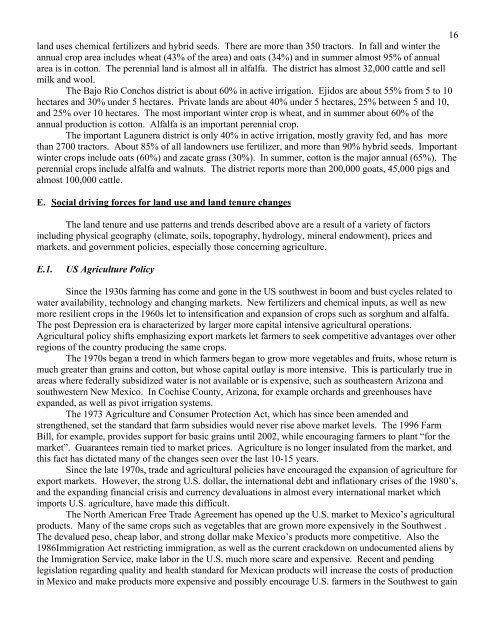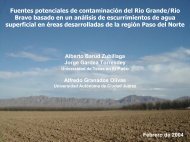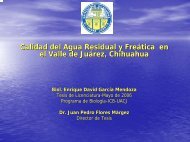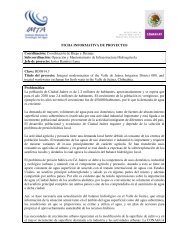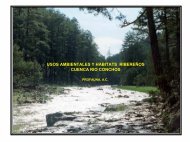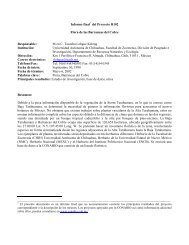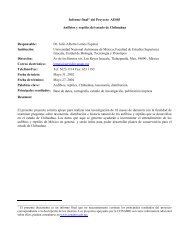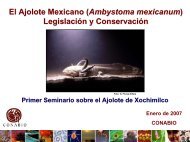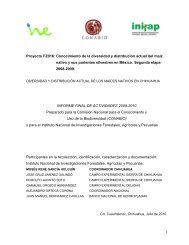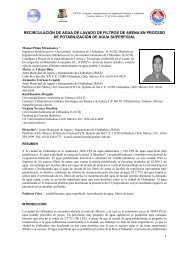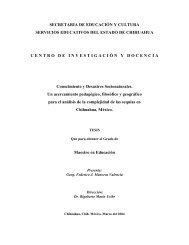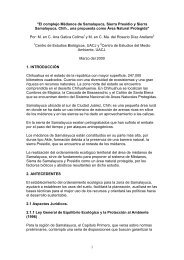16<strong>l<strong>and</strong></strong> <strong>use</strong>s chemical fertilizers <strong>and</strong> hybrid seeds. There are more than 350 tractors. In fall <strong>and</strong> w<strong>in</strong>ter <strong>the</strong>annual crop area <strong>in</strong>clu<strong>de</strong>s wheat (43% of <strong>the</strong> area) <strong>and</strong> oats (34%) <strong>and</strong> <strong>in</strong> summer almost 95% of annualarea is <strong>in</strong> cotton. The perennial <strong>l<strong>and</strong></strong> is almost all <strong>in</strong> alfalfa. The district has almost 32,000 cattle <strong>and</strong> sellmilk <strong>and</strong> wool.The Bajo Rio Conchos district is about 60% <strong>in</strong> active irrigation. Ejidos are about 55% from 5 to 10hectares <strong>and</strong> 30% un<strong>de</strong>r 5 hectares. Private <strong>l<strong>and</strong></strong>s are about 40% un<strong>de</strong>r 5 hectares, 25% between 5 <strong>and</strong> 10,<strong>and</strong> 25% over 10 hectares. The most important w<strong>in</strong>ter crop is wheat, <strong>and</strong> <strong>in</strong> summer about 60% of <strong>the</strong>annual production is cotton. Alfalfa is an important perennial crop.The important Lagunera district is only 40% <strong>in</strong> active irrigation, mostly gravity fed, <strong>and</strong> has morethan 2700 tractors. About 85% of all <strong>l<strong>and</strong></strong>owners <strong>use</strong> fertilizer, <strong>and</strong> more than 90% hybrid seeds. Importantw<strong>in</strong>ter crops <strong>in</strong>clu<strong>de</strong> oats (60%) <strong>and</strong> zacate grass (30%). In summer, cotton is <strong>the</strong> major annual (65%). Theperennial crops <strong>in</strong>clu<strong>de</strong> alfalfa <strong>and</strong> walnuts. The district reports more than 200,000 goats, 45,000 pigs <strong>and</strong>almost 100,000 cattle.E. Social driv<strong>in</strong>g forces for <strong>l<strong>and</strong></strong> <strong>use</strong> <strong>and</strong> <strong>l<strong>and</strong></strong> <strong>tenure</strong> <strong>change</strong>sThe <strong>l<strong>and</strong></strong> <strong>tenure</strong> <strong>and</strong> <strong>use</strong> patterns <strong>and</strong> trends <strong>de</strong>scribed above are a result of a variety of factors<strong>in</strong>clud<strong>in</strong>g physical geography (climate, soils, topography, hydrology, m<strong>in</strong>eral endowment), prices <strong>and</strong>markets, <strong>and</strong> government policies, especially those concern<strong>in</strong>g agriculture.E.1.US Agriculture PolicyS<strong>in</strong>ce <strong>the</strong> 1930s farm<strong>in</strong>g has come <strong>and</strong> gone <strong>in</strong> <strong>the</strong> US southwest <strong>in</strong> boom <strong>and</strong> bust cycles related towater availability, technology <strong>and</strong> chang<strong>in</strong>g markets. New fertilizers <strong>and</strong> chemical <strong>in</strong>puts, as well as newmore resilient crops <strong>in</strong> <strong>the</strong> 1960s let to <strong>in</strong>tensification <strong>and</strong> expansion of crops such as sorghum <strong>and</strong> alfalfa.The post Depression era is characterized by larger more capital <strong>in</strong>tensive agricultural operations.Agricultural policy shifts emphasiz<strong>in</strong>g export markets let farmers to seek competitive advantages over o<strong>the</strong>rregions of <strong>the</strong> country produc<strong>in</strong>g <strong>the</strong> same crops.The 1970s began a trend <strong>in</strong> which farmers began to grow more vegetables <strong>and</strong> fruits, whose return ismuch greater than gra<strong>in</strong>s <strong>and</strong> cotton, but whose capital outlay is more <strong>in</strong>tensive. This is particularly true <strong>in</strong>areas where fe<strong>de</strong>rally subsidized water is not available or is expensive, such as sou<strong>the</strong>astern Arizona <strong>and</strong>southwestern New Mexico. In Cochise County, Arizona, for example orchards <strong>and</strong> greenho<strong>use</strong>s haveexp<strong>and</strong>ed, as well as pivot irrigation systems.The 1973 Agriculture <strong>and</strong> Consumer Protection Act, which has s<strong>in</strong>ce been amen<strong>de</strong>d <strong>and</strong>streng<strong>the</strong>ned, set <strong>the</strong> st<strong>and</strong>ard that farm subsidies would never rise above market levels. The 1996 FarmBill, for example, provi<strong>de</strong>s support for basic gra<strong>in</strong>s until 2002, while encourag<strong>in</strong>g farmers to plant “for <strong>the</strong>market”. Guarantees rema<strong>in</strong> tied to market prices. Agriculture is no longer <strong>in</strong>sulated from <strong>the</strong> market, <strong>and</strong>this fact has dictated many of <strong>the</strong> <strong>change</strong>s seen over <strong>the</strong> last 10-15 years.S<strong>in</strong>ce <strong>the</strong> late 1970s, tra<strong>de</strong> <strong>and</strong> agricultural policies have encouraged <strong>the</strong> expansion of agriculture forexport markets. However, <strong>the</strong> strong U.S. dollar, <strong>the</strong> <strong>in</strong>ternational <strong>de</strong>bt <strong>and</strong> <strong>in</strong>flationary crises of <strong>the</strong> 1980’s,<strong>and</strong> <strong>the</strong> exp<strong>and</strong><strong>in</strong>g f<strong>in</strong>ancial crisis <strong>and</strong> currency <strong>de</strong>valuations <strong>in</strong> almost every <strong>in</strong>ternational market whichimports U.S. agriculture, have ma<strong>de</strong> this difficult.The North American Free Tra<strong>de</strong> Agreement has opened up <strong>the</strong> U.S. market to Mexico’s agriculturalproducts. Many of <strong>the</strong> same crops such as vegetables that are grown more expensively <strong>in</strong> <strong>the</strong> Southwest .The <strong>de</strong>valued peso, cheap labor, <strong>and</strong> strong dollar make Mexico’s products more competitive. Also <strong>the</strong>1986Immigration Act restrict<strong>in</strong>g immigration, as well as <strong>the</strong> current crackdown on undocumented aliens by<strong>the</strong> Immigration Service, make labor <strong>in</strong> <strong>the</strong> U.S. much more scare <strong>and</strong> expensive. Recent <strong>and</strong> pend<strong>in</strong>glegislation regard<strong>in</strong>g quality <strong>and</strong> health st<strong>and</strong>ard for Mexican products will <strong>in</strong>crease <strong>the</strong> costs of production<strong>in</strong> Mexico <strong>and</strong> make products more expensive <strong>and</strong> possibly encourage U.S. farmers <strong>in</strong> <strong>the</strong> Southwest to ga<strong>in</strong>
17advantage. These <strong>de</strong>velopments may have <strong>the</strong> impact of <strong>in</strong>creas<strong>in</strong>g <strong>the</strong> <strong>in</strong>tensity of agriculture as well as<strong>de</strong>term<strong>in</strong><strong>in</strong>g <strong>the</strong> mix of crops. In favor of <strong>the</strong> more valuable crops where <strong>the</strong>re is a comparative advantage.E.2.Debates over<strong>l<strong>and</strong></strong> <strong>use</strong> <strong>in</strong> <strong>the</strong> US <strong>Chihuahua</strong>n DesertAlthough <strong>l<strong>and</strong></strong> <strong>use</strong> <strong>in</strong> <strong>the</strong> US Chihuahan Desert has rema<strong>in</strong>ed fairly stable <strong>in</strong> recent years, <strong>the</strong>re areimportant pressures driv<strong>in</strong>g <strong>change</strong>s <strong>in</strong> specific places <strong>and</strong> that may <strong>in</strong>fluence future patterns. These<strong>in</strong>clu<strong>de</strong>s shifts <strong>in</strong> Fe<strong>de</strong>ral <strong>de</strong>fense spend<strong>in</strong>g that have resulted <strong>in</strong> <strong>the</strong> reductions <strong>in</strong> <strong>use</strong> of some military <strong>l<strong>and</strong></strong>s<strong>and</strong> <strong>in</strong>tensification of o<strong>the</strong>rs, such as <strong>the</strong> expansion of <strong>the</strong> base at Fort Huachuca <strong>in</strong> sou<strong>the</strong>rn Arizona.Increas<strong>in</strong>g autonomy of Indian tribes has resulted <strong>in</strong> accelerated <strong>de</strong>velopment on many tribal <strong>l<strong>and</strong></strong>s <strong>in</strong>clud<strong>in</strong>gm<strong>in</strong><strong>in</strong>g, logg<strong>in</strong>g, tourist <strong>de</strong>velopments, <strong>and</strong> expansion of irrigation.Several policy <strong>change</strong>s have occurred on resource <strong>l<strong>and</strong></strong>s managed by <strong>the</strong> US government. Forexample, <strong>the</strong> US Forest Service has shifted from a policy than emphasized susta<strong>in</strong>ed yield timber harvest<strong>in</strong>g<strong>and</strong> multiple <strong>use</strong>s for timber, recreation, watershed protection <strong>and</strong> wildlife, to a more ecosystemmanagement approach. The Bureau of L<strong>and</strong> Management has tried unsuccessfully to raise graz<strong>in</strong>g feesfrom (1.60 per cow calf unit) <strong>in</strong> or<strong>de</strong>r to recoup management costs <strong>and</strong> reduce overgraz<strong>in</strong>g. The NationalParks Service has been forced to implement people management <strong>in</strong> or<strong>de</strong>r to prevent overcrowd<strong>in</strong>g of parks<strong>and</strong> o<strong>the</strong>r protected areas. All agencies have been affected by <strong>the</strong> Endangered Species Act that requiresprotection <strong>and</strong> habitat management plans for species that are <strong>in</strong> danger of ext<strong>in</strong>ction.Many of <strong>the</strong>se policy <strong>change</strong>s have been challenged <strong>in</strong> <strong>the</strong> courts by those who wish to ma<strong>in</strong>ta<strong>in</strong> orexp<strong>and</strong> <strong>the</strong> private benefit from fe<strong>de</strong>ral <strong>l<strong>and</strong></strong>s whe<strong>the</strong>r it be low cost timber or cheap graz<strong>in</strong>g leases. Therehas also been a broa<strong>de</strong>r push to h<strong>and</strong> over fe<strong>de</strong>ral <strong>l<strong>and</strong></strong>s to state or private ownership. This so calledSagebrush Rebellion has transformed <strong>in</strong>to <strong>the</strong> Wise Use movement that believes that resources are bettermanaged <strong>and</strong> exploited <strong>in</strong> local or private ownership.There is also grow<strong>in</strong>g opposition from <strong>the</strong> property rights movement that opposes “tak<strong>in</strong>g” of <strong>l<strong>and</strong></strong>for environmental protection <strong>and</strong> fe<strong>de</strong>ral or state <strong>in</strong>terference <strong>in</strong> local <strong>l<strong>and</strong></strong> <strong>use</strong> policy.E.3.Mexican Agricultural PolicyMexican agricultural policy has been chang<strong>in</strong>g rapidly <strong>in</strong> recent years <strong>and</strong> has had important impactson <strong>l<strong>and</strong></strong> <strong>use</strong> <strong>and</strong> <strong>l<strong>and</strong></strong> <strong>tenure</strong>. The most important shifts <strong>in</strong>clu<strong>de</strong> support for export crops <strong>and</strong> livestock, <strong>the</strong>withdrawal of agricultural subsidies, <strong>the</strong> open<strong>in</strong>g to <strong>in</strong>ternational <strong>and</strong> US markets solidified by <strong>the</strong> NorthAmerican Free Tra<strong>de</strong> Agreement (NAFTA), <strong>and</strong> <strong>the</strong> dramatic reversal of <strong>l<strong>and</strong></strong> reforms allow<strong>in</strong>g <strong>the</strong>privatization of ejido <strong>l<strong>and</strong></strong>.The Mexican government has encouraged <strong>the</strong> production of gra<strong>in</strong>s, oilseeds, fruit <strong>and</strong> vegetables forexport through <strong>in</strong>vestments <strong>in</strong> irrigation districts, favorable support prices, credit for seeds <strong>and</strong> <strong>in</strong>puts, <strong>and</strong>assistance with market<strong>in</strong>g <strong>and</strong> transport. Similarly, <strong>in</strong>centives have been provi<strong>de</strong>d for stockrais<strong>in</strong>g us<strong>in</strong>gimproved breeds fed with alfalfa <strong>and</strong> <strong>in</strong>troduced grasses such as buffel.Mexico’s program of tra<strong>de</strong> liberalization ga<strong>in</strong>ed momentum when it jo<strong>in</strong>ed GATT <strong>in</strong> 1986 as part ofits effort to diversify exports away from petroleum products. Dur<strong>in</strong>g <strong>the</strong> <strong>de</strong>ca<strong>de</strong>, Mexico’s agriculturalexports to <strong>the</strong> U.S. more than doubled, from just over $1 billion <strong>in</strong> 1980 to almost $2.3 Billion <strong>in</strong> 1989although <strong>the</strong> U.S. ran a net surplus <strong>in</strong> agricultural tra<strong>de</strong> throughout this period ($3.3 billion for <strong>the</strong> <strong>de</strong>ca<strong>de</strong>).Although some Mexican products complete directly with U.S. products, many o<strong>the</strong>rs face little significantcompetition while o<strong>the</strong>rs, particularly fruits <strong>and</strong> vegetables, complement U.S. production as output peaks <strong>in</strong>different seasons. In recent years, Mexico has been <strong>the</strong> lead<strong>in</strong>g exporter of fruits <strong>and</strong> vegetables <strong>in</strong>to <strong>the</strong>U.S. (supply<strong>in</strong>g a sixth of <strong>the</strong> total <strong>in</strong> some years), start<strong>in</strong>g un<strong>de</strong>r <strong>the</strong> General System of Preferencesprogram <strong>and</strong> cont<strong>in</strong>u<strong>in</strong>g un<strong>de</strong>r NAFTA. Lead<strong>in</strong>g Mexican horticultural exports <strong>in</strong> <strong>the</strong> 1980s <strong>in</strong>clu<strong>de</strong>dtomatoes, peppers, cucumbers, onions, melons <strong>and</strong> squash.Implementation of NAFTA began on January 1, 1994, immediately elim<strong>in</strong>at<strong>in</strong>g all non tariff barriers<strong>and</strong> some tariff barriers to tra<strong>de</strong> <strong>in</strong> agricultural products with rema<strong>in</strong><strong>in</strong>g tariffs to be phased out over periods


